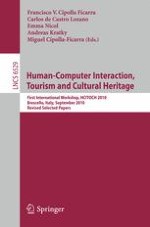2011 | Book
Human-Computer Interaction, Tourism and Cultural Heritage
First International Workshop, HCITOCH 2010, Brescello, Italy, September 7-8, 2010. Revised Selected Papers
Editors: Francisco V. Cipolla Ficarra, Carlos de Castro Lozano, Emma Nicol, Andreas Kratky, Miguel Cipolla-Ficarra
Publisher: Springer Berlin Heidelberg
Book Series : Lecture Notes in Computer Science
